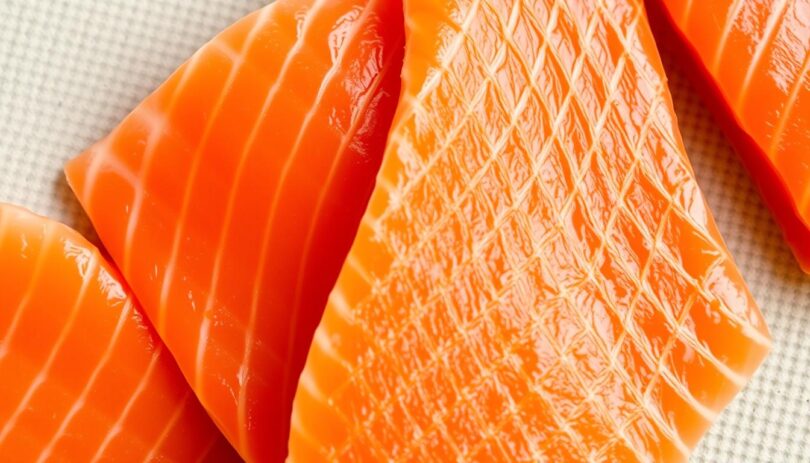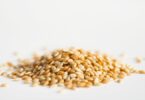34% of pet owners have shared seafood with their furry companions, yet many remain unsure about which parts are safe. This guide tackles a common question: whether that crispy salmon skin left on your plate could benefit your four-legged friend. Spoiler alert—it’s possible, but preparation matters more than you might think.
Salmon offers valuable nutrients like omega-3 fatty acids, which support joint health and shiny coats. However, not all forms are pet-friendly. Proper cooking methods eliminate risks while preserving the advantages of this protein-rich fish. For those curious about expert advice on seafood for pets, this resource breaks down the essentials.
While unseasoned, thoroughly cooked skin can be a tasty treat, raw or improperly handled portions may harbor dangerous parasites. Always remove bones and avoid additives like garlic or salt. Moderation is key, as too much fat could upset sensitive stomachs.
Before adding new foods to your pet’s menu, consult a veterinarian. Every animal has unique dietary needs—what works for one might harm another. Stay informed, stay cautious, and keep those tails wagging safely!
Nutritional Benefits of Salmon for Dogs
Packed with nutrients, this fish offers more than just a tasty meal for pets. Its natural composition makes it a powerhouse for supporting vitality and long-term wellness. Let’s explore why it’s often recommended by veterinarians.
Omega-3 Fatty Acids and Coat Health
EPA and DHA—two types of omega-3s in salmon—work wonders for skin and fur. These fatty acids reduce dryness and itching, leading to a glossier, softer coat. They also combat inflammation, easing joint discomfort in active or aging pets.
Protein and Essential Vitamins
High-quality protein fuels muscle repair and energy levels. Each serving provides amino acids critical for tissue regeneration and immune function. Vitamin B12 supports nerve health, while selenium shields cells from damage.
Together, these elements create a balanced boost for overall wellness. Just remember: moderation ensures pets reap benefits without digestive upset.
Assessing the Safety of Salmon Skin for Dogs
Salmon skin might seem like a tasty snack, but preparation determines its safety for pets. Cooking methods and existing health conditions play critical roles in whether this treat becomes beneficial or harmful.
Distinguishing Cooked Versus Raw Options
Raw salmon skin carries hidden dangers. Parasites like Nanophyetus salmincola and bacteria such as Neorickettsia helminthoeca thrive in uncooked fish. These pathogens cause salmon poisoning disease—a potentially fatal condition marked by vomiting and dehydration.
Proper cooking neutralizes these threats. Heating to 145°F (63°C) destroys harmful organisms while preserving nutrients. Always serve skin plain—seasonings like onion powder or excess oil create new risks.
Considerations for Specific Health Needs
Pets with pancreatitis or sensitive digestion require extra caution. The high fat content in salmon skin could trigger flare-ups. For allergic animals, introduce small portions and watch for itching or gastrointestinal distress.
Consult a veterinarian before offering this treat to puppies or seniors. Their developing or aging systems may struggle with rich foods. Immediate medical attention becomes crucial if lethargy or unusual symptoms appear after consumption.
can dogs eat salmon skin
Is that crispy salmon skin a smart choice for your furry companion? Let’s unpack its nutritional value and safety factors to help pet parents make informed decisions.
Nutrient Density and Health Perks
Rich in omega-3s, this fish layer supports skin hydration and reduces inflammation. Essential vitamins like B12 and D promote nerve function and bone strength. Natural oils in properly prepared portions enhance coat shine and cellular repair.
These elements work together to support immune responses and metabolic efficiency. Small servings deliver concentrated nutrition without overwhelming calorie counts. Quality sourcing ensures maximum absorption of these advantages.
Balancing Benefits With Potential Risks
While nutrient-packed, improper preparation negates salmon skin’s value. Toxic additives like onion powder or excessive salt create immediate hazards. High-fat content may challenge pets with sensitive digestion or weight concerns.
Always remove bones and cook thoroughly to eliminate parasites. Introduce new treats gradually, monitoring for allergic reactions. Partnering with a vet ensures personalized guidance for each animal’s needs.
Healthy Preparation Methods for Salmon and Salmon Skin
Turning this nutrient-rich fish into a safe treat requires careful handling. Simple techniques preserve its benefits while eliminating hazards, ensuring pets enjoy every bite without risks.
Simple Cooking Techniques for Maximum Safety
Baking or grilling at 375°F (190°C) effectively eliminates parasites while retaining nutrients. Avoid oils and butter—these add unnecessary fats that might upset sensitive stomachs. Use parchment paper to prevent sticking without added grease.
Steaming works well for maintaining moisture in the fish. Always cook skin-side down first to ensure thorough heating. Let portions cool completely before serving to avoid burns.
Remove all bones using tweezers or your fingers—even small ones pose choking risks. For extra safety, choose boneless fillets from trusted sources. Plain preparation is key: skip salt, spices, and sauces that could harm pets.
Portion sizes should match your companion’s weight and dietary needs. A teaspoon-sized piece works for small breeds, while larger animals might handle a tablespoon. Always monitor reactions after introducing new foods—similar precautions apply to shellfish treats.
Proper storage matters too. Refrigerate cooked salmon within two hours and discard leftovers after three days. Freezing uncooked fish for two weeks before preparation kills parasites naturally.
Feeding Guidelines and Appropriate Portions
Determining the right portion size makes all the difference when introducing new foods to pets. Proper measurements prevent overfeeding while allowing companions to enjoy nutritional perks without digestive distress.
Tailored Servings for Different Sizes
Weight-based recommendations help maintain balance. For extra-small companions under 20 pounds, limit fish additions to 1-2 ounces weekly. Medium-sized pets (31-50 lbs) can handle 3-4 ounces, while large breeds over 90 pounds may safely enjoy up to 8 ounces monthly.
These amounts work as supplements—not meal replacements. Always pair with complete, vet-approved dog food to meet daily nutritional needs. Treats shouldn’t exceed 10% of total calorie intake.
Observation Is Key
Watch closely during initial feedings. Loose stools or vomiting signal intolerance. Introduce flakes mixed with regular meals, starting with teaspoon portions. Gradual increases over 5-7 days help systems adapt.
Persistent itching or lethargy requires immediate veterinary attention. Keep a food journal to track reactions and adjust servings accordingly. When in doubt, smaller quantities reduce risks while testing compatibility.
Key Considerations Before Adding Salmon to Your Dog's Diet
Introducing new foods requires thoughtful planning to protect your companion's well-being. While salmon offers nutritional perks, individual factors like age, weight, and medical history influence its suitability. A proactive approach helps avoid unintended consequences while maximizing benefits.
Why Professional Guidance Matters
Veterinarians assess hidden risks you might overlook. They review medications, allergies, and chronic conditions that could clash with dietary changes. For pets with kidney issues or obesity, even small portions might worsen existing health challenges.
Sudden shifts in nutrition sometimes trigger vomiting or diarrhea. Gradual introductions allow systems to adapt safely. Your vet can create a phased feeding plan tailored to your pet’s tolerance levels.
Emergency visits spike when owners assume “natural” equals risk-free. Parasites or bacteria in improperly handled fish remain a threat despite careful preparation. Regular check-ups ensure early detection of food-related issues.
Partnering with professionals transforms guesswork into confident choices. They provide portion charts, allergy tests, and follow-up schedules to maintain your companion’s vitality. This collaboration turns good intentions into safe, effective results.
Understanding Salmon Poisoning Disease and Bacterial Risks
Raw fish carries invisible threats that every pet owner should recognize. Salmon poisoning disease stems from parasites like Nanophyetus salmincola, which host dangerous bacteria called Neorickettsia helminthoeca. This condition becomes life-threatening if untreated, with symptoms appearing 5-7 days after consumption.
Identifying Early Symptoms of Infection
Watch for vomiting, diarrhea, and sudden loss of appetite. Affected animals often develop fever above 103°F and swollen lymph nodes. Lethargy and dehydration typically follow within 24 hours of initial signs.
Steps to Prevent Bacterial and Parasitic Infections
Always cook fish to 145°F (63°C) to destroy harmful organisms. Freeze uncooked portions for two weeks before preparation—this kills parasites naturally. Avoid feeding scraps from sushi or smoked products, as these might contain raw traces.
If exposure occurs, contact a veterinarian immediately. Treatment includes antibiotics and IV fluids to combat dehydration. Prevention remains the best strategy—proper handling eliminates 98% of contamination risks according to veterinary studies.
Tips for Incorporating Salmon into a Balanced Dog Diet
Enhancing your pet's meals with nutrient-rich additions requires strategy. When used thoughtfully, fish-based elements can elevate both flavor and nutritional value without disrupting dietary balance.
Integrating Salmon as a Tasty Food Topper
Flake cooked portions into dime-sized pieces for small breeds. Mix with kibble to entice picky eaters while boosting omega-3 intake. This method delivers fatty acids that support skin hydration and joint mobility.
Limit fish additions to 10% of daily calories. Overfeeding may lead to weight gain despite the health benefits. Freeze bite-sized morsels for summer treats that double as enrichment activities.
Rotate protein sources weekly to maintain interest and nutritional diversity. Pair fish days with antioxidant-rich vegetables like steamed carrots. Always remove bones and check for hidden seasoning before serving.
Monitor reactions closely during initial introductions. Some animals develop sensitivities to specific proteins over time. Consult your veterinarian if unusual symptoms emerge after dietary changes.
Final Thoughts on Adding Salmon Treats to Your Dog’s Diet
When considering new additions to your pet’s menu, informed choices make all the difference. Properly prepared salmon skin offers valuable nutrients like omega-3s while supporting coat health—but only when cooked thoroughly and served plain.
Balance remains crucial. These treats should complement—not replace—a complete, vet-approved meal plan. Overfeeding risks digestive upset, especially for pets with sensitive systems.
Always consult your veterinarian before introducing novel foods. They’ll assess individual needs, from allergies to portion sizes, ensuring dietary changes align with overall wellness goals.
By prioritizing safety and moderation, pet parents can turn occasional fish-based rewards into beneficial enhancements. Thoughtful decisions today lay the foundation for happier, healthier tomorrows with your four-legged companion.
FAQ
Is salmon skin safe for pets to consume?
Cooked salmon skin without seasoning or oils can be safe in moderation. Avoid raw versions due to parasite risks, and always consult a veterinarian before introducing new proteins.
How does salmon benefit a pet’s coat and joints?
The omega-3 fatty acids in salmon reduce inflammation and support skin hydration, leading to a shinier coat. These nutrients also promote joint mobility, especially in older animals.
What’s the safest way to prepare salmon for pets?
Bake, steam, or poach boneless fillets without added salt, butter, or spices. Remove bones thoroughly to prevent choking hazards, and let the meat cool before serving.
Can salmon cause digestive issues in some animals?
Overfeeding fatty fish like salmon may lead to pancreatitis or gastrointestinal upset. Start with small portions (e.g., 1 tsp per 10 lbs of body weight) and monitor for reactions like vomiting or lethargy.










Leave a Comment